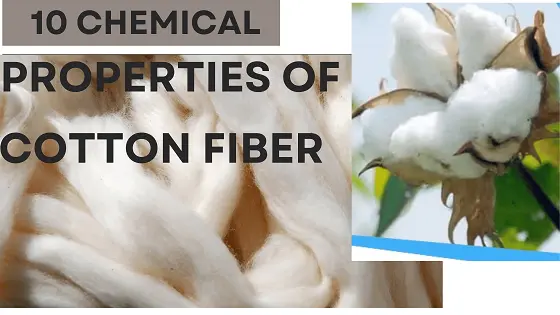10 Chemical Properties of Cotton Fiber
Cotton is the most commonly used and available natural textile fiber in the world. It is a natural vegetable fiber produced naturally in the cotton plant. It is the most important of the raw materials for the textile industry. It is easily dyeable also. As cotton is a very useful textile fiber, it has some good properties. Chemical properties are related to chemical actions. The chemical properties of cotton fiber are given below:

10 Chemical Properties of Cotton Fiber
- Effect of acids: Boiling with dilute acids will ultimately hydrolyze the cellulose to glucose. Milder action by acids at lower temperatures gives rise to tendering with the formation of hydrocellulose. Cold-concentration sulfuric acid dissolves cellulose with the formation of hydrate. Cold dilute solutions of mineral acids, unlike at the boil, have no effect upon cellulose. Nitric acid, on account of its oxidizing action, differs from other acids in its behavior towards cellulose. Immersion for a time in concentrated nitric acid causes some shrinkage accompanied by a degree of increase in tensile strength and affinity for dyestuffs.
- Effect of alkalis: Mild alkalis, such as sodium carbonate, have no action on cotton neither at low temperatures nor at high temperatures in the absence of air. In the presence of oxygen, however, oxycellulose is produced gradually with consequent tendering. Dilute solutions of strong alkalis such as sodium hydroxide act in very much the same way. Cellulose is affected by more concentrated solutions of sodium hydroxide in a complex manner.
- Action of water: Water, which is very strong and polar in nature, is easily attacked by the polar –OH group of the cotton fiber. So that water is able to penetrate into the cellulose network of the cotton fiber. This water absorption causes swelling of the fiber.
- Effect of bleach: All kinds, NaOCl, and sodium perborate are common. H2O2 is the least harmful.
- Effects of Insects: Cotton is not attacked by moth grubs or beetles.
- Action of microorganism: Cotton fibers can resist moths and most insects but it can be attacked by fungi and bacteria.
- Organic solvent: Resistance to organic solvent. So dry wash is possible.
- Affinity for dyes: Cotton has a good affinity for dyes. It is dyed best with vat dyes, but azoic and reactive dyes may also be effectively used. Colorfastness is generally good, but specific conditions should be considered.
- Effect on heat: Cotton can be heated in a dry state to 150ºC without undergoing decomposition, but if the heating is prolonged a brown color develops gradually. A very slight brown discoloration can occur at temperatures lower than 150ºC, which causes no deterioration in the fiber but is sufficient to spoil the effect of bleaching. Exposure to air during a long period, especially in the presence of sunlight, will have an effect upon cotton similar to that of dry heat. At about 2400C temperature cotton is decomposed and the Ignition temperature of cotton is 390 0C.
- Colorfastness: Cotton fiber has very good colorfastness properties in both yarn and fabric form.
Conclusion
A thorough understanding of the chemical Properties of Cotton Fiber is crucial for many sectors, including environmental science, agriculture, and the textile industry. Through the utilization of cotton’s distinct chemical properties, scientists and producers might create inventive procedures and goods that optimize cotton’s innate qualities while reducing their negative effects on the environment.
In conclusion, the chemical makeup and physical attributes of cotton fiber greatly influence its features, functionality, and uses. Cotton’s chemistry supports its standing as a versatile and sustainable natural fiber, favored by consumers and industries globally, from its hydrophilic nature to its dye affinity and reactivity.
- References: https://www.ijert.org/research/study-of-mechanical-and-surface-properties-on-some-chemical-treated-cotton-fabric-by-kes-f-sem-and-ftir-analysis-IJERTV3IS051442.pdf
- https://jtcps.journals.ekb.eg/article_29862_fc83e20b350df52f917c9ec3bbf93186.pdf
- https://www.scribd.com/doc/101550453/Dyeing-and-Chemical-Technology-of-Textile-Fibres
- You may love to read: Advantages, Disadvantages, and Uses of Cotton Fiber
